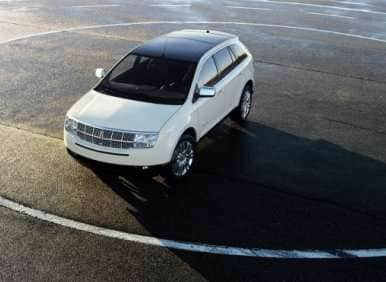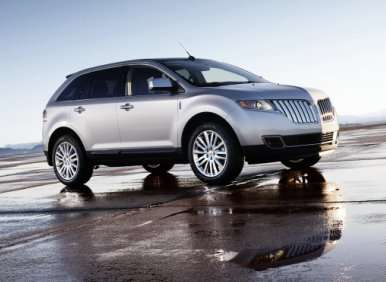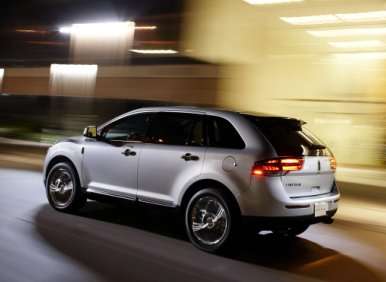Recent Articles
Popular Makes
Body Types
Lincoln MKX Used SUV Buying Guide

There was a time, in the ever-increasingly distant past, when Lincoln absolutely owned the domestic luxury SUV market. The company’s full-size Navigator sport utility vehicle had steered Lincoln directly into tremendous sales in that segment.
In fact, the company was so successful with the American market’s first true domestic luxury SUV, GM dealers threatened mutiny. (OK, that’s a bit of an overstatement.) Let’s just say they were very perturbed when Cadillac had no direct competitor for the Navigator. To alleviate that situation, the Cadillac nameplate, along with and the wreath and crest badging and the name Escalade were affixed to a very mildly restyled GMC Yukon Denali.
Turns out, the Navigator’s primary customer had more love for that Cadillac wreath and crest than it did for Lincoln’s four-pointed star. As a result, the Navigator soon fell out of favor, even though the Navigator was arguably the better of the two vehicles.
In the mid-size segment, Lincoln followed the Navigator with the Aviator, also a traditional body-on-frame SUV like its Navigator bigger brother. By the time Aviator debuted though, the SUV customer (having been spoiled by the likes of the Lexus RX, Infiniti FX and yes, Cadillac’s SRX, had matured. They expected a quieter, more comfortable and more luxurious demeanor from their mid-size luxury SUV. Aviator, derived as it was from the truck-based Ford Explorer, simply wasn’t capable of bringing the lux the way the car-based crossover utility vehicles could.
BTW, if the phrase crossover utility vehicle is a new term for you, it essentially refers to an automobile with the ride height and profile of an SUV, but rather than being based on a truck like most SUVs are, the crossover utility vehicle (CUV) is typically based on a car. Think car, crossed with SUV and you’ll have the idea. In the case of the Lincoln Aviator’s replacement — the MKX — that car was the front-drive Ford Fusion, from which the Mercury Milan, Lincoln MKZ and Mazda6 are also derived.
In addition to the Lincoln, Ford Motor Company offers the Ford Edge and the Mazda CX-9 CUVs based on the Fusion’s platform. Ford’s Edge is the closest spiritual sibling to the MKX, with the two sharing pretty much everything other than their wheels, interiors, and front and rear exterior styling treatments.
Introduced in 2006, as a 2007 model, there has only been one generation of the MKX and a significant design update for 2011.
2006-2010 Lincoln MKX
Interestingly, the vehicle we now know as the MKX, originally debuted in 2004 at the Detroit Auto Show (also known as the North American International Auto Show) as the Lincoln Aviator Concept. However, rather than the flowing waterfall grille featured on the production version of the MKX of today, the Aviator Concept used the classic “eggcrate” grille from Lincoln’s Continental line of cars, as did the MKX for its first five years of production
Power for that 2007 Lincoln MKX was supplied by a 265-horsepower, 3.5-liter V6 spinning out 250 ft-lbs of torque. Available in both front- and all-wheel drive configurations, the MKX uses a six-speed automatic transmission and is capable of towing up to 3,500 pounds when equipped with its optional towing package.
It has been written in a number of places, and we agree; Lincoln offers the nicest interior treatments of all American automobile manufacturers. Their designs typically involve a nod to the past glories of the marque, while incorporating a healthy dose of contemporary luxury features.
In the case of the MKX, the retro-metallic finish of the dash and angular instrumentation was contrasted brilliantly with genuine wood accents and cutting edge (for the time) tech such as THX audio. Offered in one trim level, but with a bunch of available packages, that first Lincoln MKX featured; Leather upholstery throughout, along with eight-way power adjustment for both front seats as standard fare. One-touch front windows, dual-zone automatic climate control, and a leather-and-wood steering wheel marked the Lincoln as a true luxury intender.
If the MKX was ordered with the Elite Package, the vehicle also featured Lincoln’s Vista Roof, which was comprised of a sliding front sunroof in concert with fixed rear skylight. The Elite Package also featured a navigation system and a 14-speaker surround-sound audio system fed by an in-dash six-CD/MP3 player and satellite radio.
If you wanted the maximum in bling appeal from your MKX, the move was to get up on the Ultimate Package. That’s how you got the chrome wheels, heated and cooled seats, adaptive headlights, a power rear liftgate and 10-way power front seats with memory.
Some of those items of course were offered as standalone options as well. Heated rear seats and audible park assist were offered, as well as satellite radio, and a DVD-based video entertainment system.
Traction control and stability control were standard safety features, in addition to six airbags — encompassing a set of front-seat side impact airbags, along with full-length side curtain airbags. Antilock disc brakes and a tire-pressure monitor were standard on every Lincoln MKX as well. Speaking of the brakes, many reviewers of the time commented negatively about the rather long stopping distances posted by the MKX during testing (as well as its Ford Edge cousin).
Notably missing from the MKX was the availability of a third-row seat, which many of its competitors offered. Although, honestly, in a mid-size SUV CUV, the third row seating position is generally useless for the vast majority of the population. So it winds up either folded away most of the time to increase cargo capacity — or removed altogether. For that reason, we don’t really view that omission as a neg. However, when it came to cargo capacity, more than a few of its competitors also bested the Lincoln MKX.
2008
In an effort to improve their CUV’s offerings, Lincoln’s MKX product planners decreed reverse parking sensors, satellite radio, and heated and cooled seats with memory be added to the roster of standard kit for the MKX. The Microsoft-develeoped Sync telematics system enabling the control of communication and entertainment devices like cell phones, PDAs, iPods and other MP3 players via voice commands was incorporated into the MKX as well, facilitating the addition of voice activation for the navigation system. Also added to the standard feature set of the MKX as a result of the Microsoft Sync system, were Bluetooth hands-free telephony and fully functioning iPod compatibility.
Two new equipment packages were added for 2008, the Limited Edition Package, which fitted a set of 20-inch wheels to the MKX, and the Monochrome Limited Edition, which rendered the grille in the MLE’s body color (black only).
2009
For 2009, Lincoln upgraded the navigation system — improving its graphic interface considerably. Sirius Travel Link piped weather information, fuel prices, sports scores, and movie listings directly into the MKX — along with Sirius satellite radio. Lincoln’s product team also specified a service similar to GM’s OnStar for the MKX, which calls 911 for emergency support if an airbag is deployed.
2010
The Midnight Limited Edition Package debuted with 22-inch wheels as its primary feature. A sport tuned suspension system was also incorporated to improve the MKX’s handling and carry the additional weight of the larger wheel set.

Current Model 2011 Lincoln MKX
For the 2011 model year, Lincoln reworked the MKX considerably. While the overall size and shape remained the same, the exterior facelift incorporated Lincoln's new winged waterfall grille, recalling Lincoln models from the 1930s. The new curvaceous front fenders and a new set of taillights completed the exterior upgrade.
Inside, higher-quality materials, redesigned seats, and richer accent touches including genuine aluminum trim brought the Lincoln’s passenger compartment more in line with that of its competition. A new interface for the Sync multimedia control system, called MyLincoln Touch, operated like the touchscreen of a smartphone’s — in addition to accepting additional voice commands. Standard features of the 2011 Lincoln MKX included a power tailgate, remote start, power front seats with heating and ventilation, leather upholstery and rear parking sensors.
The brakes were addressed as well, so the 2011 MKX stopped shorter and with more confidence than previous iterations of the CUV.
In summary, standard features for the 2011 Lincoln MKX encompassed keyless ignition/entry, audible parking sensors for the Lincoln’s rear, auto-dimming interior and driver-side exterior mirrors. The Lincoln also featured 18-inch alloy wheels and a capless fuel filler. As its name implies, there is no gas cap. The fuel filler flap seals the tank when closed. The Lincoln’s MyKey system enabled owners to limit the MKX's top speed and radio volume to help keep younger drivers safe when borrowing the vehicle.
Further, a power liftgate, dual-zone automatic climate control, leather seating, heated and ventilated power front seats, driver memory functions, and a tilt-and-telescoping steering column are found on every 2011 Lincoln MKZ.
On the tech front, MyLincoln Touch and the Microsoft Sync electronics interface systems (including Bluetooth and iPod interfaces) carried over from the 2010 model. The base audio system was a 10-speaker affair fed by a CD player, satellite radio, USB/iPod/auxiliary audio device input jacks and an SD card reader.
Opting for the Premium package added 18-inch polished alloy wheels, adaptive xenon headlights, rain-sensing wipers, a rearview camera, interior mood lighting, a heated/power-adjustable steering wheel, upgraded leather upholstery and heated second-row seats.
Upgrading to the Elite package got all that aforementioned kit, plus 20-inch chrome wheels, a panoramic sunroof, a blind spot warning system, an upgraded THX-certified audio system and a hard-drive-based navigation system featuring 10 gigs of digital music storage and Sirius Travel Link.
The Limited Edition package captured 20-inch polished alloy wheels; bronze leather upholstery with black accents, unique textured metallic interior trim and monogrammed floor mats.
Motive force for the 2011 Lincoln MKZ is supplied by a 305-horsepower, 3.7-liter V6, producing 280 ft-lbs of torque. As before, buyers can choose between front- and all-wheel drive and the engine’s power is channeled to the drive wheels via a six-speed automatic transmission. The tow rating, when the Lincoln is properly equipped, remained 3,500 pounds —even with the newfound power of the 3.7-liter V6.
Safety gear included antilock disc brakes, stability and traction control, front side airbags and side curtain airbags. A blind spot warning system was optional.

Summary
For much of its existence — as nice as the Lincoln MKX has always been — the CUV has been upstaged by its imported adversaries. Even Cadillac’s SRX crossover, based as it is on the outstanding Cadillac CTS sport sedan, has been a more compelling offering than the Lincoln in many ways.
However, the fact remains the Lincoln MKX is a good-looking vehicle with all the right luxury cues to embody that indefinable attribute known as presence. That said, while the Lincoln may lag in terms of overall content and driving pleasure, it does look good. For many people — particularly on the secondary market — that, plus a good price are more than enough.
And on that front, the Lincoln does have both.
It’s also been recalled a bit over the years, so you’ll want to run a vehicle history report on any MKX you’re seriously considering in addition to an Internet search for Lincoln MKX recall, incorporating your model year of interest.
As we mentioned, the brakes are an issue with the Lincoln crossover so you’ll want to make sure you’re comfortable with those as well. To that end, nothing will tell you more about the relative health and well being of any pre-owned car than a thorough pre-purchase inspection by a trusted professional mechanic well-versed in the particulars of your vehicle of choice.
